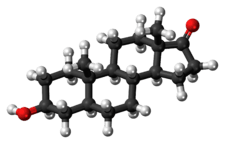Epiandrosterone
 | |
 | |
| Clinical data | |
|---|---|
| ATC code | none |
| Identifiers | |
| |
| CAS Number |
481-29-8 |
| PubChem (CID) | 441302 |
| ChemSpider |
390065 |
| UNII |
8TR252Z538 |
| ChEBI |
CHEBI:541975 |
| ChEMBL |
CHEMBL272195 |
| Chemical and physical data | |
| Formula | C19H30O2 |
| Molar mass | 290.440 g/mol |
| 3D model (Jmol) | Interactive image |
| |
| |
| (verify) | |
Epiandrosterone, or isoandrosterone,[1][2] also known as 3β-androsterone, 3β-hydroxy-5α-androstan-17-one, or 5α-androstan-3β-ol-17-one, is a steroid hormone with weak androgenic activity. It is a metabolite of testosterone and dihydrotestosterone (DHT). It was first isolated in 1931, by Adolf Friedrich Johann Butenandt and Kurt Tscherning. They distilled over 17,000 litres of male urine, from which they got 50 milligrams of crystalline androsterone (most likely mixed isomers), which was sufficient to find that the chemical formula was very similar to estrone.
Epiandrosterone has been shown to naturally occur in most mammals including pigs.[3]
Epiandrosterone is naturally produced by the enzyme 5α-reductase from the adrenal hormone DHEA.[4][5][6][7] Epiandrosterone can also be converted from the natural steroids androstanediol via 17β-hydroxysteroid dehydrogenase or from androstanedione via 3β-hydroxysteroid dehydrogenase.
See also
References
- ↑ Samuel H. Yalkowsky; Yan He; Parijat Jain (19 April 2016). Handbook of Aqueous Solubility Data, Second Edition. CRC Press. pp. 1209–. ISBN 978-1-4398-0246-5.
- ↑ Natural Products. Krishna Prakashan Media. 2006. pp. 298–. ISBN 978-81-87224-85-3.
- ↑ Raeside JI, Renaud RL, Marshall DE. Identification of 5 alpha-androstane-3 beta,17 beta-diol and 3 beta-hydroxy-5 alpha-androstan-17-one sulfates as quantitatively significant secretory products of porcine Leydig cells and their presence in testicular venous blood. J Steroid Biochem Mol Biol. 42(1):113-20, 1992
- ↑ Callies F, Arlt W, Siekmann L, Hübler D, Bidlingmaier F, Allolio B. Influence of oral dehydroepiandrosterone (DHEA) on urinary steroid metabolites in males and females. Steroids. 65(2):98-102, 2000
- ↑ Labrie F, Cusan L, Gomez JL, Martel C, Bérubé R, Bélanger P, Chaussade V, Deloche C, Leclaire J. Changes in serum DHEA and eleven of its metabolites during 12-month percutaneous administration of DHEA. J Steroid Biochem Mol Biol. 2008 May;110(1-2):1-9
- ↑ Daniël Henri van de Kerkhof. Steroid profiling in doping analysis. [S.l.] : [s.n.], 2001 - Tekst. - Proefschrift Universiteit Utrecht
- ↑ Acacio BD, Stanczyk FZ, Mullin P, Saadat P, Jafarian N, Sokol RZ. Pharmacokinetics of dehydroepiandrosterone and its metabolites after long-term daily oral administration to healthy young men. Fertil Steril. Mar;81(3):595-604, 2004
Further reading
- Simons RG, Grinwich DL. Immunoreactive detection of four mammalian steroids in plants. Can J Bot 67: 288-296, 1989
- Janeczko A, Skoczowski A. Mammalian sex hormones in plants. Folia Histochem Cytobiol. 2005;43(2):71-9.Labrie F, Bélanger A, Labrie C, Candas B, Cusan L, Gomez 4. JL. Bioavailability and metabolism of oral and percutaneous dehydroepiandrosterone in postmenopausal women. J Steroid Biochem Mol Biol. 107(1-2):57-69, 2007
- Uralets VP, Gillette PA. Over-the-counter delta5 anabolic steroids 5-androsen-3,17-dione; 5-androsten-3beta, 17beta-diol; dehydroepiandrosterone; and 19-nor-5-androsten-3,17-dione: excretion studies in men. J Anal Toxicol. 24(3):188-93, 2000